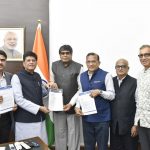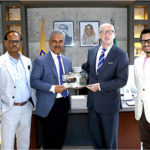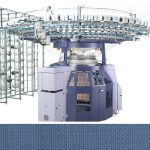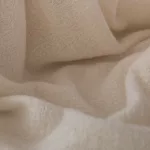The Synthetic & Rayon Textiles Export Promotion Council (SRTEPC) made a presentation before the Drawback Committee on 20th May 2012 at the Committee Room of the Council in Mumbai. The Drawback Committee has been constituted by the Ministry of Finance, Government of India, for looking into the various aspects of the Duty Drawback Scheme and to recommend All Industry Rates of Duty Drawback for different export products. The Committee members present at the Council’s presentation meeting were Dr. Saumitra Chaudhuri, Member, Planning Commission & Chairman of the Drawback Committee and Shri T. R. Rustagi (Retired), Chief Commissioner of Customs and Central Excise and Member of the Drawback Committee. Shri Rajiv Talwar, Joint Secretary (Drawback) was also present during the presentation meeting. This was a part of an annual exercise of the Department of Revenue to review all existing Drawback rates by considering the changes in the Duty structure in the Union Budget.
Shri Vinod K. Ladia, Chairman SRTEPC welcomed the members of Drawback Committee. The Meeting was attended by the members of the Committee of Administration of the Council.
In his opening remarks, Mr. Ladia emphasized the need for enhancement in the Drawback rates for all synthetic textile items, especially in the context of increase in the Excise Duty on Man-Made Fibres and Filament yarns, from 10% to 12%. He also pointed out that suitable increase in the Drawback rates was crucial to the growth of exports of synthetic textile items which have huge potential for production and exports. Mr. Ladia informed that the share of man-made
fibre consumption globally was around 68% but in India it is 34%. Moreover, the share of MMF textiles in total textiles exports from India amounts to only 17% and therefore there is tremendous scope to increase the share of MMF textiles in production and exports.

Dr. Saumitra Chaudhuri (centre), Chairman of the Drawback Committee interacting with the members of the SRTEPC Committee of Administration during the Drawback Presentation
Exports of Indian MMF textiles have grown steadily over the last 5 years and exports during 2011-12 is expected to surpass the target and touch US$ 5.64 billion. The share of value added textiles like fabrics and made-ups have gone up and account for 64% of the exports. Though Middle East continues to be the biggest market with 25%; Asia, North & South America and Africa also account for substantial amount of exports. Countries like Pakistan and Saudi Arabia have emerged as the top markets for Indian MMF textiles. The Council has been given an export target of US$6.5 billion for the year 2012-13 and to achieve this ambitious target exporters have to be supported with appropriate rates of Drawback.
According to SRTEPC, the following factors were affecting the textile exports :
- Increase in prices of man-made fibres & yarns by domestic products.
- Raw materials of MMF textiles controlled by limited producers.
- Non-availability of specialty fibres and yarns from domestic producers resulting in less development in the emerging sectors like Technical Textiles.
- High cost of production due to higher cost of inputs like Power, Interest, etc.
- Shortage of trained man power.
- Discriminatory Excise Duty on man-made fibres/ yarns vis-à-vis cotton.
- High Transaction costs due to un-neutralized state level taxes such as CST, VAT, Octroi, Entry Tax, etc.
- Stiff competition from China and ASEAN Countries.
- Crisis in EU, Slow recovery in the US and political instability in the Middle East.
SRTEPC emphasized that value caps for most of the MMF textile items are extremely low and hence the same should be removed or revised upwards especially to encourage exports of value added items which earn extra foreign exchange for the country. Indian exports suffer due to high interest rates and efforts should be made to reduce the interest burden on Indian exporters to make them competitive.
SRTEPC delegation suggested that the number of items in Drawback Schedule should be reduced and the rates streamlined for simplification and administrative convenience and to avoid confusion among the exporters. Regarding the state levies and the transaction costs, which remain un-neutralized the exporters, the Chairman urged the Committee to factor these while fixing the revised Drawback rates.
During the presentation, detailed calculations were provided for various product lines such as polyester viscose yarn, polyester spun yarn, polyester filament yarn, polyester staple fibre, viscose staple fibre, polyester filament fabrics, polyester viscose fabrics, non-woven fabrics, etc. with justification for an increase in the existing drawback rates for all these products.
SRTEPC further proposed that it would be submitting more proposals for fixing Drawback for additional items along with the necessary supporting documents. This was agreed to by the Drawback Committee constituted by the Ministry of Finance, Government of India,






